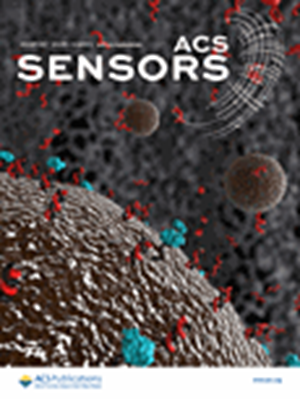以噬菌体 MS2 为受体、基于表面阻断的电位计生物传感器用于检测大肠杆菌 ATCC 15597
IF 9.1
1区 化学
Q1 CHEMISTRY, ANALYTICAL
引用次数: 0
摘要
如今,使用电位离子传感器来实现对生物分析物的检测仍然是一个巨大的挑战,因为这些分析物通常不会产生可测量的离子信号。为了应对这一挑战,我们提出了一种基于延迟 Nernstian 响应的简单而稳健的电位计传感协议,用于生物分析物的无标记检测。所提出的传感器平台由两层组成:表面识别层和指示离子选择电极(ISE)膜层。它基于一种表面阻滞机制,即表面识别元件与目标物之间的表面识别相互作用可阻碍指示离子从水相扩散到传感膜相,以达到最终的能斯特反应平衡,从而产生延迟电位变化。这种电位变化可用于测量样品中生物目标的浓度。因此,利用噬菌体 MS2、其宿主大肠杆菌 ATCC 15597(缩写为大肠杆菌 H)和固体接触丁酰胆碱 ISE 分别作为表面识别元件、目标和指示电极,设计出了一种传感系统。这一新概念为检测大肠杆菌 H 提供了一种简单、灵敏且选择性极高的电位法,其检测限为 100 CFU mL-1。预计本方法将为使用 ISE 检测临床和环境应用中各种重要的非离子生物目标铺平道路。本文章由计算机程序翻译,如有差异,请以英文原文为准。

Surface Blocking-Based Potentiometric Biosensor for Detection of E. coli ATCC 15597 Using Phage MS2 as a Receptor
Nowadays, using a potentiometric ion sensor to achieve detection of biological analytes is still a big challenge, since these analytes usually do not yield a measurable ion signal. To address this challenge, a simple and robust potentiometric sensing protocol based on a delayed Nernstian response is proposed for the label-free detection of biological analytes. The proposed sensor platform is composed of two layers: the surface recognition layer and the indicator-ion-selective electrode (ISE) membrane layer. It is based on a surface blocking mechanism in which the surface recognition interactions between the surface recognition element and the target can impede the diffusion of the indicator ion from the aqueous phase to the sensing membrane phase to reach the final Nernstian-response equilibrium, thus resulting in a delayed potential change. Such a potential change could be used to measure the concentration of a biological target in the sample. Thus, a sensing system was designed by using phage MS2, its host bacterium Escherichia coli ATCC 15597(abbreviated as E. coli H), and a solid-contact butyrylcholine ISE as a surface recognition element, a target, and an indicator electrode, respectively. This new concept offers a simple, sensitive, and extremely selective potentiometric method for detection of E. coli H with a detection limit of 100 CFU mL–1. It can be expected that the present approach may pave the way to using ISEs to detect various important nonionic biological targets in clinical and environmental applications.
求助全文
通过发布文献求助,成功后即可免费获取论文全文。
去求助
来源期刊

ACS Sensors
Chemical Engineering-Bioengineering
CiteScore
14.50
自引率
3.40%
发文量
372
期刊介绍:
ACS Sensors is a peer-reviewed research journal that focuses on the dissemination of new and original knowledge in the field of sensor science, particularly those that selectively sense chemical or biological species or processes. The journal covers a broad range of topics, including but not limited to biosensors, chemical sensors, gas sensors, intracellular sensors, single molecule sensors, cell chips, and microfluidic devices. It aims to publish articles that address conceptual advances in sensing technology applicable to various types of analytes or application papers that report on the use of existing sensing concepts in new ways or for new analytes.
 求助内容:
求助内容: 应助结果提醒方式:
应助结果提醒方式:


